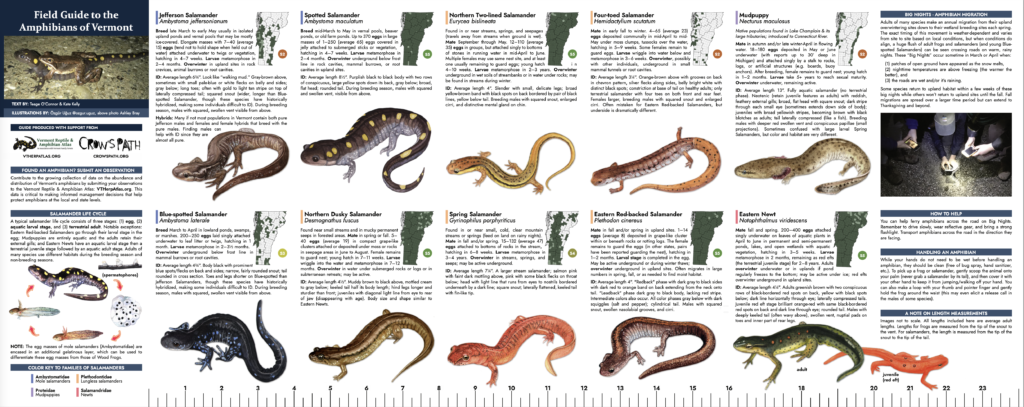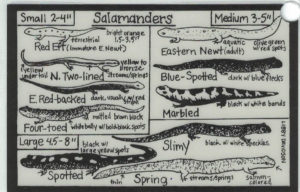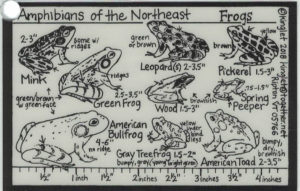In addition to the recommended sources listed below, you may find the print and web resources listed on our Additional Reading or Management Resources pages helpful.
Jump down to:
Identification | Natural History | Calls| Websites
Identification (field guides/books)
A few good field guides to reptiles and amphibians exist. These help you identify herptiles but do not give you life history information. One that is easy to find and helpful is listed below but be aware it is not always accurate with its local distribution information in our area.
Powell, R., R. Conant, and J.T. Collins. 2016. Peterson field guide to reptiles and amphibians of Eastern and Central North America. Fourth edition. Houghton Mifflin Company, Boston, Massachusetts. 494 pp.
Identification posters
The posters listed below contain photos, distribution maps, and identification information on all of Vermont’s species. They can be purchased through the posters page on this website. All income from the posters helps support our efforts.
Andrews, J.S. and A.K. Burgess, 2006. Native Vermont Reptiles Part 1: Snakes and Lizards
Andrews, J.S. and A.K. Burgess, 2006. Native Vermont Reptiles Part 2: Turtles
Andrews, J.S. and A.K. Burgess, 2007. Native Vermont Amphibians Part 1: Frogs
Andrews, J.S. and A.K. Burgess, 2007. Native Vermont Amphibians Part 2: Salamanders
Amphibian Identification Guide
In collaboration with Crow’s Path, we’ve developed a foldable, durable field guide to Vermont’s amphibians. It’s printed on waterproof, tearproof paper so it can weather any wetland and it folds down to about the size of a wallet (4×5.5″) so you can stuff it in your pocket while out herping. With details specific to Vermont populations, you’ll have the most relevant information to help make identification a breeze. Learn more and purchase for $15 at https://www.vtherpatlas.org/support-and-funding/amphibian-field-guide/
Identification cards
We worked with our friends at Kinglet to put together identification cards to commonly seen amphibians of the Northeast. These laminated, pocket-sized cards (3 7/8″ x 2 1/2″) provide identification notes and tips for most of our Vermont amphibians and a few from further south. They can be purchased through the Green Mountain Club‘s website. Make sure to select “Amphibians of the Northeast” from the dropdown menu.
Identification | Natural History | Calls | Websites | Top
Natural History
These resources focus less on identification and more on natural history, local distribution, and conservation. Many of these titles are out of print but you can often find used copies online or through your library.
Breisch, A. R. (text) and M. Patterson (illustrator). 2017. The snake and the salamander: reptiles and amphibians from Maine to Virginia. Johns Hopkins University Press, Baltimore, Maryland.
Not a field guide or a distribution guide, but a good source of local natural history information.
Franke, V., and J. Andrews. 2008. Rattlers, peepers, and snappers: the first complete DVD guide to all the amphibians and reptiles that breed in New England. Peregrine Productions, Waterbury, VT.
This guide includes field trips, songs, quizzes, and information on the natural history, identification, and conservation of all of New England’s herptiles.
Gibbs, J.P., A.R. Breisch, P.K. Ducey, G. Johnson, J.L. Behler, and R.C. Bothner. 2007. The amphibians and reptiles of New York State: identification, natural history, and conservation. Oxford University Press, New York. 422 pp.
This is the local guide that I use in my classes. It includes all Vermont species.
Harding, J.H. and D.A. Mifsud. 2017. Amphibians and reptiles of the Great Lakes Region: revised edition. The University of Michigan Press, Ann Arbor, Michigan. 392 pp.
All our species are included.
Holland, M. 2013. “What a snake’s eyes can tell you”. Naturally Curious with Mary Holland (online). Accessed September 7, 2013 at http://naturallycuriouswithmaryholland.wordpress.com/2013/08/23/what-a-snakes-eyes-can-tell-you/.
Round and elliptical pupils have different advantages.
Hulse, A., C. J. McCoy, and E. Censky. 2001. Amphibians and reptiles of Pennsylvania and the Northeast. Cornell University Press, Ithaca, New York. 419 pp.
Most of our species are included.
Hunter, M.L., A. Calhoun, and M. McCullough (eds.). 1999. Maine amphibians and reptiles. University of Maine Press, Orono, Maine. 272 pp.
This edition includes a very useful CD of local frog calls.
Klemens, M.W. 1993. Amphibians and reptiles of Connecticut and adjacent regions. State Geological and Natural History Survey of Connecticut, Bulletin No. 112. 318 pp.
Klemens, M.W. 2021. Conservation of Amphibians and Reptiles in Connecticut. Department of Energy and Environmental Protection, Hartford, Connecticut. Revision to State Geological and Natural History Survey Bulletin 112.
Krulikowski, L. 2007. Snakes of New England: a photographic and natural history study. Self-published. 320 pp.
Mills, P. B., 2016. Metamorphosis: Ontario’s amphibians at all stages of development. Self-published. 104 pp.
Ontario has almost all the same species as New England.
This is a very useful small guide that is particularly helpful with ID of amphibian larvae in the field. To order, visit the author’s website at http://www.peterbmills.com/metamorphosis.html
Tyning, T.F. 1990. A Guide to amphibians and reptiles. Little, Brown and Company, Boston, Massachusetts. 400 pp.
Identification | Natural History | Calls | Websites | Top
Calls
Cornell University: Macauley Library (audio, online). Accessed October 4, 2022 at http://macaulaylibrary.org/.
The Macaulay Library is a scientific archive of audio and video recordings under the auspices of Cornell University. Analog records as far back as 1929, as well as more recent digital ones, are available.
Eliot, L. 2004. The Calls of Frogs and Toads. Stackpole Books, Mechanicsburg, Pennsylvania.
Includes audio recordings.
Franke, V., and J. Andrews. 2008. Rattlers, peepers, and snappers: the first complete DVD guide to all the amphibians and reptiles that breed in New England. Peregrine Productions, Waterbury, VT. Now available here!
Myers, P., R. Espinosa, C. S. Parr, T. Jones, G. S. Hammond, and T. A. Dewey. 2022. The Animal Diversity Web (online). Accessed October 4, 2022 at https://animaldiversity.org.
A selection of frog calls is available at http://animaldiversity.org/collections/frog_calls/
The examples of frog calls are in several audio formats (.mp3, .wav, .aiff,.au) so you may need a variety of players.
Identification | Natural History | Calls | Websites | Top
Websites
Many useful sites exist. Some provide more reliable information than others. A few reliable sites, some with many links to other resources, are listed below. We also recommend a few local natural-history and herp blogs as well. Links should open in a new window or tab.
Amphibian and Reptile Conservancy
http://amphibianandreptileconservancy.org/
AmphibiaWeb
an excellent source of information on amphibians
http://www.amphibiaweb.org/
Animal Diversity Web
A selection of frog calls is available at http://animaldiversity.org/collections/frog_calls/
The examples of frog calls are in several audio formats (.mp3, .wav, .aiff,.au) so you may need a variety of players.
The Canadian Herpetological Society Identification Key to Reptiles and Amphibians
http://canadianherpetology.ca/species/
Herpetofaunal Disease Resources
https://parcplace.org/resources/herpetofaunal-disease-resources/
Site includes herpetofaunal disease fact sheets, and descriptions of how to disinfect to reduce the spread of disease.
New York State Amphibian and Reptile Atlas Project (1990-1999)
http://www.dec.ny.gov/animals/7140.html
and more about Herps from NYS Department of Conservation
Northeast Partners in Amphibian and Reptile Conservation (NEPARC)
http://www.northeastparc.org/
Northeast Turtles
http://www.northeastturtles.org/
The Orianne Society: Egg Mass Identification
https://www.oriannesociety.org/faces-of-the-forest/egg-mass-identification-great-northern-forests/
The Orianne Society’s blog post describing egg mass identification for Vermont’s spring breeding amphibians.
Partners in Amphibian and Reptile Conservation (PARC)
http://www.parcplace.org/
PARC is “dedicated to the conservation of the herpetofauna–reptiles and amphibians–and their habitats”. Membership is free.
Peabody Museum of Natural History, Yale University: Online Guide to the Reptiles and Amphibians of Connecticut
http://peabody.yale.edu/collections/vertebrate-zoology/herpetology/online-guide-amphibians-and-reptiles-connecticut
The Reptile Database
http://www.reptile-database.org
Society for the Study of Amphibians and Reptiles (SSAR)
http://www.ssarherps.org/
The Snakes of Massachusetts
http://www.masnakes.org/
Includes all our local snakes.
University of Massachusetts: Center for Agriculture – Research and Extension
http://ag.umass.edu/cafe/fact-sheets/fish-wildlife-biodiversity-fact-sheets
Downloadable documents on Fish, Wildlife & Biodiversity, from mitigating transportation impacts to wetland assessment to additional links.
University of Michigan Animal Diversity Web
http://animaldiversity.org/
Or jump straight to their Reptile or Amphibian sections. The amphibian section includes examples of frog calls in several formats.
Blogs
There are several good blogs out there for herpers and natural history buffs and other friends and fans of the outdoors. Some we particularly like include:
AFK: herping by Kiley Briggs
http://herping.blogspot.com/
Naturally Curious
http://naturallycuriouswithmaryholland.wordpress.com/
North Branch Nature Center
http://northbranchnaturecenter.blogspot.com/




